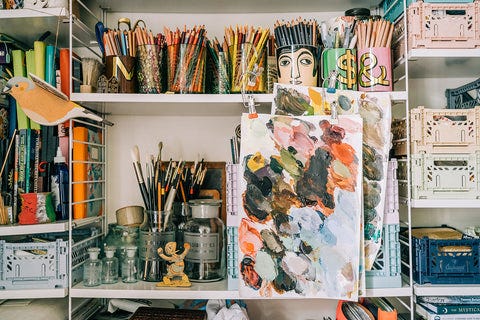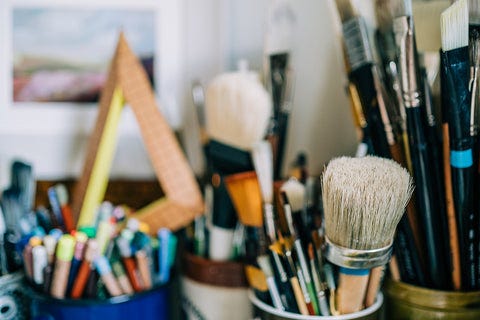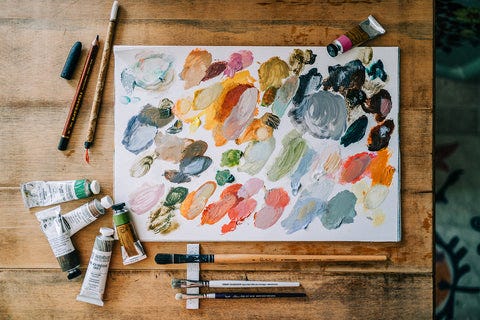
Oil Paint - being environmentally aware and safe in the studio
Marna LuntAs with most things in life today, what we do can have a grave impact on the natural world. Painting is no exception and it is my responsibility as an artist to alleviate my impact as best I can.

I want to talk about oil paint here, rather than watercolour and acrylic. Why I chose oil as my medium, what it's made up of, how to stay safe when using it, how to responsibly dispose of it.
Why did you choose oil paint instead of acrylic? My medium of choice is oil; paint, pigment sticks and pastels. I love the sensory input that only oil can give me, the creamy texture, the way it will pull at the brush as it dries and becomes tacky. I love the marks it makes with a rough old hog brush and when scratched into by pencil or charcoal. I love adding mediums so that I can play with glazes and create layers. I love the deep rich colours that create a dense feeling of earth, that for an unknown reason I can’t feel when using acrylic. I love how versatile they become when you learn to play with them. I never considered the health and safety aspects of the medium at all when I started.
What is traditional oil paint & water soluble oil paint? Traditional oils are a classic mix of pigment in a binder of drying oil - typically linseed oil. The pigments are evenly dispersed in the binder using a meticulous milling process which results in the rich, buttery consistency typical of oil paints. Water soluble oil paint is an alternative modern version. It mimics oil paint but eliminates the issue of solvents and the safety elements those entail. The modified oil binder means paints can be thinned with water or their consistency altered with special water-mixable mediums. All water based paints dry quicker than tradition oil paint and they can lighten on the canvas when they dry where as oil paints retain their colour even after drying. Which is why traditional oil paints are often referred to as richer and with dense pigmentation. My preference is traditional oil paint but water soluble oil paint is a good choice for people with allergies, pets, or for those who work in the home. It’s entirely a personal choice.
What is actually inside oil paint? All paint is made with a pigment and a binder. In traditional oil paint, the binder is highly refined vegetable oil, considered kitchen grade, such as linseed, safflower, poppy, and walnut. Oils dry slowly creating a hard film of paint when they come in contact with air. A dry skin forms over the paint surface in a few days or weeks, the paint underneath will slowly harden over time sometimes months or years. Oil paints, on their own, don’t release any chemicals into the air as they dry, solvents like Turpentine are the toxic part of oil painting, so unless you’ve added solvents or mediums containing petroleum distillate to your paint during the painting process you'll be fine. Otherwise these harmful solvents will evaporate into your studio space. It's best if you want to be safe, open your windows, consider an air purifier and make sure to keep any mediums in an air tight container while you're painting during the day. Paint covered rags are best left outside when not in use or stored in a container.
So that covers the binder now what about the pigment? All paint contains pigment, pigments have varying degrees of toxicity. Many of the most toxic pigments are no longer used in oil paint manufacture and have been replaced with safer alternatives. There are a few toxic ones, like lead-white, cadmium, and cobalt, but they are only toxic if you eat or breathe in the dry pigment before the oil is mixed. These colours can also be substituted for synthetic alternatives, which are even safer to use.
Some people can grow allergic to paints if exposed to them for a long period of time. You can use barrier creams and gloves to help minimise the long term effects. The main reason for wearing gloves is to make cleaning easier and to stop solvents penetrating the skin. All paint manufacturers have lots of information on their websites about the pigments and will always label the paints to advise of safety issues.
Why do people bother buying the expensive artist grade paints? Researching and investing in the best artist materials I can afford is so important to me, every artist is different though so no judgement here. To paint, you do not have to have the finest materials, there are no rules, but this is why I choose to buy artist grade oil paint.
Artist quality materials are materials designed for people that are exposed to and long term use of paint and who want to sell their work. They have selected the best pigments and binders to give you:
-
Longevity - the pigments are the best quality (more vibrant), the processing takes longer (finer milled), there is less filler (more pigment), lightfastness (tests having been done over a long period)
-
Safety - Clear labelling and information
-
Reliability and consistency - thorough regular quality control checks implemented by the manufacturer
The main difference is pigment quality and content. In more expensive paints there will be a high concentration of pigment, around 75% compared to cheaper ones, some having as little as 23%. With professional paints, each colour will have a different texture, consistency, sheen and drying time that is caused by the natural characteristics of the pigment. If the pigments used aren't lightfast with good quality binders and varnishes for longevity then the work won't last and you've bought yourself a very expensive poster.
Because one of my main reasons for loving oil paint is the history behind the medium and the sensory joy I get from using it, these elements are important to me when painting. I want to produce something that will last long after I do, a ‘permanent painting’. If my painting were being sold at a car boot sale in 150 years time I'd be happy. I'd be even happier if they were in the national gallery. I think it more than fair for a collector to expect their work to last for at least 50 or more years. Anyway I digress...
Oil paints biggest environmental impact is its incorrect disposal and that’s up to us individually.
Harsh chemicals and toxins, when disposed of incorrectly leak into watersheds and can pollute waterways and groundwater. All paint and solvent waste must be treated as hazardous. Here are some tips for dealing with waste in your studio.
-
Firstly reuse your solvent/oil/thinner. I do this by having a few large jam jars as my containers. I put walnut oil or gamsol in one and when it gets too cloudy and sludgy to use I put it to one side with the lid on and start a fresh jam jar. Over night or a few nights at most the sediment in my first jam jar will sink to the bottom of the pot. You can then decant the clear solvent into a fresh jar, use it again, and wipe the sediment from the bottom of your first jar with a rag or piece of kitchen paper towel. So altogether I will have a fresh jar of thinner, a jar that is separating and a clean jar waiting for recycled thinner. And I use these on a rotation basis.
-
The rags from cleaning sludge go in a sealed bin. Keep this separate and labeled. You don't want kids or animals getting to it.
-
To clean your brushes wipe the excess paint from your brushes onto a rag (odd socks, ripped up old sheets/ t-shirts etc) or some old newspaper. Then dab them into a little vegetable oil and work the oil into the bristles with your fingers, getting the remainder of the paint out of the bristles. Wipe the excess off with rags again and dab in oil again. Do this until no more paint is coming out of your brushes.
-
You can then wash your hands and brushes with soap and water.
-
To clean your palette, whether wooden or glass, scrape the paint from your palette using a palette knife, wipe the remaining excess paint away with an old rag, and then clean the rest away by pouring a bit of oil on the surface and wiping with another rag. Place rags in your toxic waste bin, sealed.
-
Leaving oil-soaked rags or paper towels piled up in the open air is a fire hazard and the fumes are toxic and not ideal to be left hanging around.
-
Paint covered rags are best stored in a container. Preferably mark for hazardous use and soak the rags in water first as they are flammable. Oily rags generate heat as they dry and can spontaneously combust if they’re crushed together in storage.
-
Disposal of rags. Do not pop them in your kitchen bin and out with all your other rubbish, this will make its way into the water system as well as release toxins into the air. If you go to your local tip they will have hazardous waste disposal and be able to show you where to throw it away safely. If you dispose of this sort of waste regularly then you can get a specialist to collect it for you.
Nothing should go down the sink, the loo, the drain or into your household rubbish because it will eventually find its way into the water system and landfill.
Disclaimer: I’m not a qualified health and safety or hazardous waste expert so any advice above is based on my own time served experience as an artist, coupled with my research. If in any doubt about how to use any of the materials or mediums mentioned in this post please speak directly to manufacturers or an expert. Any use of any of the above materials should be undertaken in line with manufacturers guidelines and if in a professional setting, in line with appropriate risk assessments by trained personnel.






